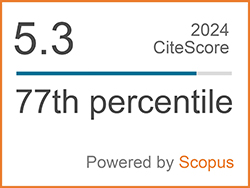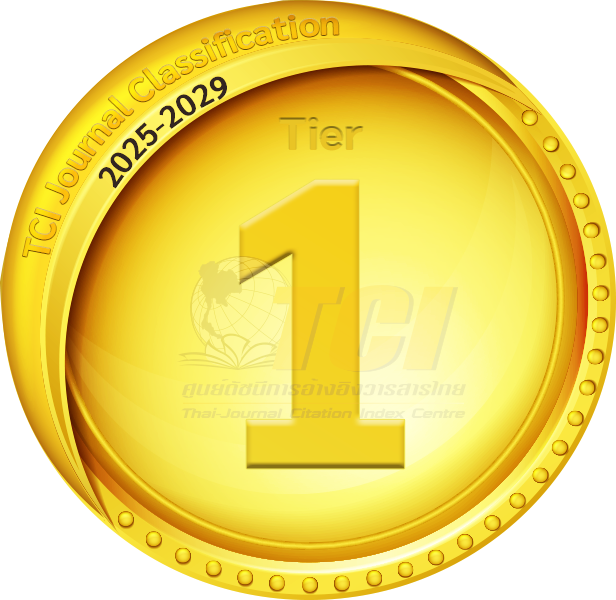Enhanced Broad-Spectrum Protection Against High-Energy Visible Light Using Co-Doped Ag2O and ZnO–TiO2 Nanocomposites
Abstract
Keywords
[1] X. Zhang and X. Zhao, “The impact of blue light exposure on public health and protective strategies,” Current Research in Medical Sciences, vol. 3, pp. 60–66, 2024, doi: 10.56397/ CRMS.2024.06.08.
[2] H. W. Lim, I. Kohli, E. Ruvolo, L. Kolbe, and I. H. Hamzavi, “Impact of visible light on skin health: The role of antioxidants and free radical quenchers in skin protection,” Journal of the American Academy of Dermatology, vol. 86, no. 3S, pp. S27–S37, Mar. 2022, doi: 10.1016/j.jaad. 2021.12.024.
[3] F. Liebel, S. Kaur, E. Ruvolo, N. Kollias, and M. D. Southall, “Irradiation of skin with visible light induces reactive oxygen species and matrix-degrading enzymes,” Journal of Investigative Dermatology, vol. 132, no. 7, pp. 1901–1907, Jul. 2012, doi: 10.1038/jid.2011.476.
[4] C. Regazzetti et al., “Melanocytes sense blue light and regulate pigmentation through Opsin-3,” Journal of Investigative Dermatology, vol. 138, no. 1, pp. 171–178, Jan. 2018, doi: 10.1016/ j.jid.2017.07.833.
[5] R. Campiche et al., “Pigmentation effects of blue light irradiation on skin and how to protect against them,” International Journal of Cosmetic Science, vol. 42, no. 4, pp. 399–406, Aug. 2020, doi: 10.1111/ics.12637.
[6] S. J. Cooper and G. T. Bowden, “Ultraviolet B regulation of transcription factor families: Roles of nuclear factor-kappa B (NF-κB) and activator protein-1 (AP-1) in UVB-induced skin carcinogenesis,” Current Cancer Drug Targets, vol. 7, pp. 325–334, 2007, doi: 10.2174/156800 907780809714.
[7] J. Cihlar Jr., E. Bartonickova, and J. Cihlar, “Low-temperature sol–gel synthesis of anatase nanoparticles modified by Au, Pd and Pt and activity of TiO2/Au, Pd, Pt photocatalysts in water splitting,” Journal of Sol-Gel Science and Technology, vol. 65, pp. 430–442, 2013, doi: 10.1007/s10971-012-2955-8.
[8] J. Cihlar, V. Kasparek, M. Kralova, and K. Castkova, “Biphasic anatase-brookite nanoparticles prepared by sol–gel complex synthesis and their photocatalytic activity in hydrogen production,” International Journal of Hydrogen Energy, vol. 40, pp. 2950–2962, 2015, doi: 10.1016/ j.ijhydene.2015.01.008.
[9] M. C. Ceballos-Chuc, C. M. Ramos-Castillo, J. J. Alvarado-Gil, G. Oskam, and G. Rodríguez-Gattorno, “Influence of brookite impurities on the Raman spectrum of TiO2 anatase nanocrystals,” Journal of Physical Chemistry C, vol. 122, pp. 19921–19930, 2018, doi: 10.1021/ acs.jpcc.8b04987.
[10] M. H. Yang et al., “Anatase and brookite TiO2 with various morphologies and their proposed building block,” CrystEngComm, vol. 16, pp. 441–447, 2014, doi: 10.1039/c3ce41750f.
[11] S. Rakhimkulov et al., “Synthesis and application of zinc oxide nanoparticles,” Research Journal of Chemistry and Environment, vol. 28, pp. 947–966, 2024.
[12] N. Sedefoglu, “Characterization and photocatalytic activity of ZnO nanoparticles by green synthesis method,” Optik, vol. 288, p. 171217, 2023, doi: 10.1016/j.ijleo.2023.171217.
[13] D. K. Sharma, S. Shukla, K. K. Sharma, and V. Kumar, “A review on ZnO: Fundamental properties and applications,” Materials Today: Proceedings, vol. 49, pp. 3028–3035, 2022, doi: 10.1016/j.matpr.2020.10.238.
[14] X. Chen, L. Liu, P. Y. Yu, and S. S. Mao, “Increasing solar absorption for photocatalysis with black hydrogenated titanium dioxide nanocrystals,” Science, vol. 331, pp. 746–750, 2011, doi: 10.1126/science.1200448.
[15] Y. Liu et al., “Synthesis of Cu, N-doped TiO2 nanotube and study on photoelectric properties,” Pre-Print, 2018, doi: 10.20944/preprints 201808.0203.v1.
[16] K. Siwińska-Stefańska et al., “TiO2-ZnO binary oxide systems: Comprehensive characterization and tests of photocatalytic activity,” Materials, vol. 11, p. 841, 2018, doi: 10.3390/ma11050841.
[17] A. Mazabuel-Collazos and J. E. Rodríguez-Páez, “Chemical synthesis and characterization of ZnO–TiO2 semiconductor nanocomposites: Tentative mechanism of particle formation,” Journal of Inorganic and Organometallic Polymers and Materials, vol. 28, pp. 1739–1752, 2018, doi: 10.1007/s10904-018-0827-6.
[18] A. Toghan, A. Modwi, M. Khairy, and K. K. Taha, “Influence of TiO2 concentration on the characteristics of ZnO nanoparticles fabricated via sonication assisted with gelatin,” Chemical Physics, vol. 551, p. 111350, 2021, doi: 10.1016/ j.chemphys.2021.111350.
[19] M. B. A. Taee and B. M. A. Shabander, “Study the Effect of ZnO Concentrations on The Photocatalytic Activity of TiO2/Cement Nanocomposites,” Chemistry Methodology, vol. 6, no. 11, pp. 831–841, 2022, doi: 10.22034/ chemm.2022.352379.1578.
[20] P. M. Smijs and S. Pavel, “Titanium dioxide and zinc oxide nanoparticles in sunscreens: Focus on UV attenuation,” Advances in Colloid and Interface Science, vol. 123–126, pp. 31–40, 2011.
[21] L. M. Santos et al., “Structural characterization of Ag-doped TiO₂ with enhanced photocatalytic activity,” RSC Advances, vol. 5, no. 125, pp. 103752–103759, 2015, doi: 10.1039/C5RA19309K
[22] N. Mokrani, E. G. Temam, H. B. Temam, H. Barkat, and M. Althamthami, “Enhancing water purification with light-activated strontium-doped ZnO thin films,” Advances in Natural Sciences: Nanoscience and Nanotechnology, vol. 16, no. 1, p. 015012, 2025, doi: 10.1088/2043-6262/ada005.
[23] E. G. Temam, F. Djani, S. Rahmane, H. B. Temam, and B. Gasmi, “Photocatalytic activity of Al/Ni doped TiO₂ films synthesized by sol-gel method: dependence on thickness and crystal growth of photocatalysts,” Surfaces and Interfaces, vol. 31, p. 102077, 2022, doi: 10.1016/j.surfin.2022.102077.
[24] M. Grätzel, B. O’Regan, and D. Fitzmaurice, “Structural and optical studies of TiO₂:Ag₂O nanocomposites by sol-gel method,” Journal of Materials Chemistry, vol. 1, pp. 547–558, 1991.
[25] X. Jaramillo-Fierro, S. González, H. A. Jaramillo, and F. Medina, “Synthesis of the ZnTiO3/TiO2 nanocomposite supported in ecuadorian clays for the adsorption and photocatalytic removal of methylene blue dye,” Nanomaterials (Basel), vol. 10, no. 9, p. 1891, doi: 10.3390/nano10091891.
[26] C. Byrne, R. Fagan, S. Hinder, D. E. McCormack, and S. C. Pillai, “New approach of modifying the anatase to rutile transition temperature in TiO₂ photocatalysts,” RSC Advances, vol. 6, no. 97, pp. 95232–95238, 2016, doi: 10.1039/C6RA19759K.
[27] E. A. Reynoso-Soto et al., “Photocatalytic degradation of nitrobenzene using nanocrystalline TiO₂ photocatalyst doped with Zn ions,” Journal of the Mexican Chemical Society, vol. 57, no. 4, pp. 298–305, 2013.
[28] M. Kumar, S. Sheoran, and S. Bhattacharya, “Exploring chalcohalide perovskite-inspired materials (Sn₂SbX₂I₃; X = S or Se) for optoelectronic and spintronic applications,” Journal of Physical Chemistry Letters, vol. 14, no. 45, pp. 10158–10165, 2023, doi: 10.1021/acs.jpclett.3c02475.
[29] D. Ramírez-Ortega, A. M. Meléndez, P. Acevedo-Peña, I. González, and R. Arroyo, “Semiconducting properties of ZnO/TiO2 composites by electrochemical measurements and their relationship with photocatalytic activity,” Electrochimica Acta, vol. 140, pp. 541–549, 2014, doi: 10.1016/j.electacta. 2014. 06.060.
[30] R. Mohamed et al., “Facile synthesis of mesoporous Ag₂O–ZnO heterojunctions for efficient promotion of visible light photodegradation of tetracycline,” ACS Omega, vol. 5, no. 51, pp. 33269–33279, 2020, doi: 10.1021/acsomega.0c 04969.
[31] N. A. Erfan, M. S. Mahmoud, H. Y. Kim, and N. A. Barakat, “Synergistic doping with Ag, CdO, and ZnO to overcome electron-hole recombination in TiO₂ photocatalysis for effective water photo splitting reaction,” Frontiers in Chemistry, vol. 11, p. 1301172, 2023, doi: 10.3389/fchem.2023. 1301172.
[32] P. Yang et al., “Ball-milling of titanium dioxide and zinc oxide for enhanced UV protection,” Frontiers in Materials, vol. 10, p. 1273659, 2023, doi: 10.3389/fmats.2023.1273659.
[33] M. Adzis, I. R. Shah, K. Saeed, and S. Abdullah, “Modification of silver oxide/silver doped titanium dioxide (Ag₂O/Ag-TiO₂) photocatalyst using an immobilized reverse photocatalytic reactor (IPR),” Materials, vol. 16, no. 5, p. 1805, 2023, doi: 10.3390/ma16051805.
[34] G. G. Riungu, S. W. Mugo, J. M. Ngaruiya, G. M. John, and N. Mugambi, “Optical band energy, Urbach energy and associated band tails of nano crystalline TiO₂ films at different annealing rates,” American Journal of Nanosciences, vol. 7, no. 1, pp. 28–34, 2021.
[35] A. Naldoni et al., “Effect of nature and location of defects on bandgap narrowing in black TiO₂ nanoparticles,” Journal of the American Chemical Society, vol. 134, no. 18, pp. 7600–7603, 2012.
[36] H. Nezzal et al., “Photo-deposition of AgO thin films on TiO₂ substrate for (PN) hetero-junction applications: Considering the degree of contamination,” Journal of Alloys and Compounds, vol. 1010, p. 177331, 2025.
[37] N. Mokrani et al., “Boosting photocatalytic stability: hydrophilic Sr-doped ZnO thin films prepared via the SILAR method for enhanced performance over multiple cycles,” Physica Scripta, vol. 99, no. 9, p. 0959a4, 2024.
[38] N. A. Mohamed, T. K. Ibrahim, and H. M. Ibrahim, “UV protection and antibacterial activities of ZnO/TiO₂ nanocomposites,” Materials Chemistry and Physics, vol. 242, p. 122642, 2020, doi: 10.1016/j.matchemphys.2019.122642.
[39] M. Baalousha, A. M. Pyle, and A. Lead, “An overview of the environmental fate and toxicity of titanium dioxide nanoparticles,” Science of The Total Environment, vol. 717, p. 137212, 2020, doi: 10.1016/j.scitotenv.2020.137212.
[40] J. Ye, Z. Qian, H. Li, and X. Jiang, “Photocatalytic performance of anatase TiO₂ with surface modifications,” Catalysis Today, vol. 231, pp. 120–130, 2014.
[41] Z. Li, J. Shen, and X. Li, “Synergistic effect of ZnO and TiO₂ in enhancing photocatalytic properties,” Applied Surface Science, vol. 487, pp. 634–642, 2019.
[42] Y. Wu et al., “Enhanced visible light photocatalytic activity of ZnO/TiO₂ heterojunction nanocomposites,” Journal of Alloys and Compounds, vol. 790, pp. 552–559, 2019.
[43] M. Zhang, Y. Yu, and H. Wang, “Photoelectrochemical properties of TiO₂/ZnO composites for water splitting,” Journal of Materials Science: Materials in Electronics, vol. 30, no. 24, pp. 22116–22124, 2019.
[44] S. Li et al., “Band structure engineering of TiO₂-based photocatalysts for enhanced visible light activity,” Applied Catalysis B: Environmental, vol. 238, pp. 1–9, 2018.
[45] A. Kumar, S. K. Sharma, and M. Kumar, “Recent advances in TiO₂-ZnO composites for photocatalytic applications,” Materials Today Chemistry, vol. 14, p. 100198, 2019.
[46] H. Zhao, Z. Liu, and W. Li, “Synthesis and photocatalytic activities of ZnO/TiO₂ heterojunction nanostructures,” Journal of Photochemistry and Photobiology A: Chemistry, vol. 370, pp. 80–88, 2019.
[47] R. Sharma, A. D. Yadav, and P. Kumar, “Visible light-driven photocatalytic degradation of pollutants using ZnO/TiO₂ composites,” Environmental Science and Pollution Research, vol. 27, pp. 12256–12268, 2020.
DOI: 10.14416/j.asep.2025.09.009
Refbacks
- There are currently no refbacks.
 Applied Science and Engineering Progress
Applied Science and Engineering Progress







